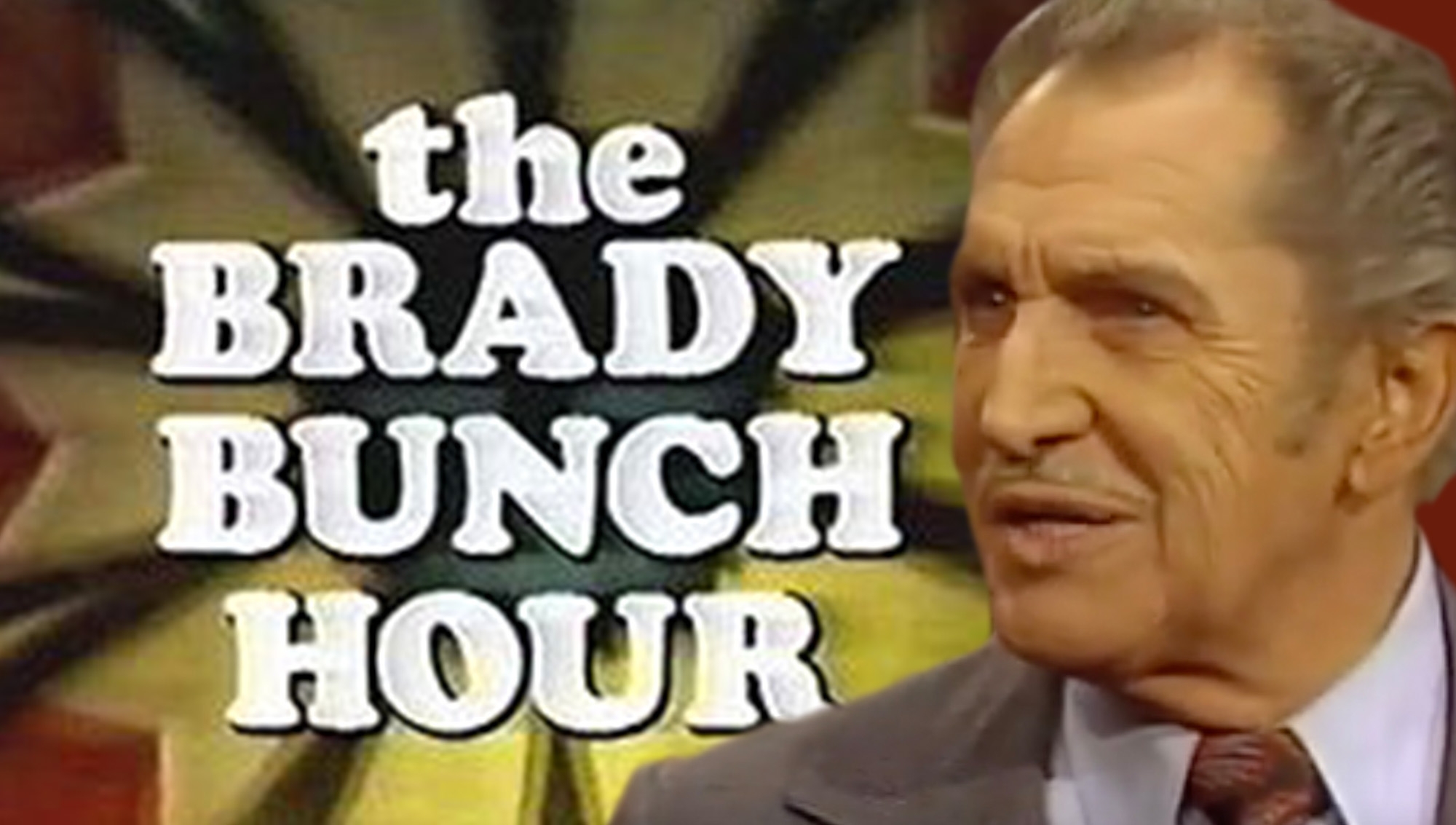A very special 1970s nightmare, starring Vincent Price, H.R. Pufnstuf, and the Brady Bunch


In the 1970s, just about anyone with a Q Score in the double digits landed their own variety series. Musicians, comedians, magicians… if you had any kind of name recognition at all, you were issued a spangled jumpsuit and consigned to a flashing stage in a Burbank television studio, where you were required to sing, dance, and read dumb jokes off of cue cards.
Not even the Bradys were excused. From 1969 to 1974, six adorable young actors played siblings in a blended family, in a modestly successful sitcom starring showbiz vets Robert Reed and Florence Henderson as newlyweds raising kids from their previous marriages. When The Brady Bunch went off the air, the reruns became a surprise hit in syndication, grabbing younger audiences who’d watch the old episodes over and over, every afternoon after school. That’s how children’s television impresarios Sid and Marty Krofft got involved with the franchise, and turned a genial family comedy into one of the most surreal and misbegotten products of a bizarre pop culture decade.
The Brady Bunch Variety Hour debuted as a one-off special on November 28, 1976, and did well enough to get picked up as an irregular series, airing every few weeks throughout the first half of 1977. Dropping the “variety” from the title—but not the premise—The Brady Bunch Hour brought back most of the sitcom’s original cast, not as themselves, but as the characters they’d been playing on TV for much of the previous half-decade. Reed was still Mike Brady, Henderson was still Carol Brady, and so on. (There was notable exception: Geri Reischl replaced Eve Plumb as the Bradys’ eternally neglected middle child, Jan. More on that in a moment.)
The central idea of The Brady Bunch Hour—very loosely explained and adhered-to throughout the series—was that The Brady Bunch that America had watched for so many years was a true story about real people, who’d become so famous from being on television that they’d been given their own variety show. (To reiterate: This was the ’70s.)
Similar to The Muppet Show, each episode of The Brady Bunch Hour offered a family-friendly assortment of big musical numbers and vaudeville-style performances, broken up by snippets of backstage melodrama, often involving that week’s special guests. Unlike The Muppet Show, those “behind the scenes” segments involved flashbacks to life in and around the Brady household. Essentially, The Brady Bunch Hour snuck new episodes of The Brady Bunch between all the high-stepping hoop-de-do.
The episode of The Brady Bunch Hour that aired on March 4, 1977, begins with a pair of lengthy performances by the full Brady family, who belt out the Depression-era standard “(Keep Your) Sunny Side Up” before the first commercial break, and then the contemporary Broadway showtune “It’s Not Where You Start” immediately after. After the first song—performed in mustard-colored costumes meant to approximate “the sun”—the family bickers over who should introduce that week’s show, with eldest son Greg (Barry Williams) taking particular offense that his lines keep getting stepped on. This lays the groundwork for what happens after the second song, where Carol say that they chose “It’s Not Where You Start” because of a recent family crisis that “once it started we didn’t know where or how it was going to finish.”
Cue the flashback, which begins in the Brady living room—not the familiar one from the sitcom, but a nondescript new one constructed for the variety show. There we see Greg, trying to write a song with his acoustic guitar, and constantly getting interrupted by the rest of the clan. Finally, he gets frustrated, and makes an announcement: He’s moving out, and he already has a new apartment secured thanks to the Bradys’ realtor neighbor Jack (played by Rip Taylor). Once Greg’s set up in his new place, though, he’s disappointed in how crummy it looks, and how empty it feels. At one point, after he calls home and hears how heartbroken his mom is by his absence, the two share a kind of dream-duet, with Carol singing Classics IV’s soft rock smash “Traces” and Greg answering with Eric Carmen’s “All By Myself.”
Let’s unpack all this, shall we? We can leave aside the questionable decision to have a mother sing, about her boy, “Traces of love, long ago, that didn’t work out right,” while her stepson sings about how when he was young, “Makin’ love was just for fun.” Instead, let’s contemplate the oddity of this episode’s actual plot, which presumes that it’s some kind of traumatic event when a 22-year-old man moves out of his parents’ house. Out in the real world of 1977, young folks were smoking dope and sleeping around. But in the Brady-verse, no one ever grew up, or changed, or engaged with their own generation.
This cuts to the weird core of The Brady Bunch Hour. The Krofft brothers basically licensed the characters who were on TV every afternoon, and who’d appeared in the short-lived animated series The Brady Kids toward the end of the sitcom’s run. The Kroffts seemed determined to put exactly those characters into this variety show, even though the actors who played them no longer physically resembled the cute little kids they once were. So Susan Olsen’s Cindy was expected to behave like a naive, doll-toting toddler, even though she was very visibly a teenager; and the similarly mature Mike Lookinland was supposed to be the same overeager, scheming Bobby Brady he’d been before.
In an interview included on a DVD set of The Brady Bunch Hour, Olsen and Lookinland talk about what a miserable experience they had making the show. Lookinland says that he had a hard time even understanding the concept when it was initially explained to him. As for Olsen, when she heard that Eve Plumb would be skipping this project because she had a burgeoning career in TV movies, she cracked, “Don’t we all have something better to do?”—and promptly got a dirty look from Henderson.
As for the freakiness of the Bradys suddenly having a new Jan, Olsen and Lookinland collectively shrug and insist that Jan’s just a role, not a person. They compare the change to what happened on their animated series, where a contract dispute led to half of the Brady Kids actors getting dropped and replaced halfway through the run. It’s all business, Lookinland explains, adding, “You don’t ever turn down work in Hollywood if you want to work in Hollywood.”
That comment could serve as the motto for The Brady Bunch Hour: a show that has all the creative spark of a prenuptial agreement. The original Brady Bunch was no masterpiece, but it did display a warmth and an upbeat outlook that at least partially justifies its enduring presence in American pop culture. Many years ago in this column, I wrote, “The plot of any given Brady Bunch barely mattered; people tuned in then and probably still tune in now just to spend time in one family’s cool-looking house in a relatively carefree southern-California suburb. The show is more an environment than a piece of narrative art.” I stand by that assessment.
The Brady Bunch Hour, by contrast, is largely indistinguishable from its competition. The guest list for its brief run include the usual ’70s variety show mix of always-available veteran stars (Milton Berle, Edgar Bergen, Tony Randall) and era-specific perennials (Paul Williams, Charo, Rich Little). In the episode where Greg moves out, he ends up living down the hall from a man played by horror icon Vincent Price, who claims that the apartment is haunted. (Reportedly, The Mary Tyler Moore Show’s Ted Knight was supposed to play the role but cancelled, so kudos to the Brady Bunch Hour writers for at least trying to make the character’s business Price-specific.) During the musical segments, the Krofft company cross-promotes by bringing in its signature Saturday morning TV character H.R. Pufnstuf in to do a number. It’s all eerily familiar to anyone who grew up in the variety age.
One could argue that what sets The Brady Bunch Hour apart is its rank incompetence—but even that’s not entirely true. Watch Pink Lady & Jeff sometime, or Tony Orlando And Dawn… or really almost anything from the ’70s variety genre, which wasn’t exactly renowned for its creative spark. The Brady show tried to mix things up by adding an aquatic element, replacing most variety shows’ chorines and dancers with a troupe of swimmers, doing water ballet in a big tank built into the stage. But even with all the splashing around, for the most part, the musical numbers were pro forma: a mix of moldy oldies and modern Top 40, performed by eight sitcom actors of wildly varying singing and hoofing abilities.
The Broadway-trained Henderson gave her all to The Brady Bunch Hour, and both looks and sounds genuinely fabulous in footage from the show. (That may explain why she glared at her younger costars whenever they seemed less than thrilled to be there.) Reed, on the other hand, is terrible in the musical segments, although everyone who worked on the show has said that he had a blast doing them… which was unusual, since Reed tended to be at least mildly resentful of nearly all things Brady Bunch.
Would anyone even remember The Brady Bunch Hour today if not for its most heinous elements? If not for Replacement Jan, or Vincent Price as a spooky neighbor, or guest appearances by H.R. Pufnstuf, or the way that nobody seems to be doing the same choreography during the wide shots, would The Brady Bunch Hour have been parodied by The Simpsons, released on home video, and inspired an entire coffee table book co-written by Olsen?:
Here’s the truth about ’70s variety shows: They were all, in their own way, as mind-bending and reality-warping as The Brady Bunch Hour. Sonny and Cher, Donny and Marie, the Mandrell sisters… when they were shoved in front of a studio audience for an hour each week, they were all asked to narrow their personality traits down to one or two that could register on the average-sized American family room TV set. Who was the dumb one? Who was the vain one? Who took themselves too seriously? On the continuum of televised “reality,” talk shows and game shows often present celebrities at their loosest and most natural, while variety shows and (ironically) reality TV are stiffer, more staged, and less nuanced. That’s the deal. It’s a devil’s bargain that entertainers have entered into ever since the era of Glen Campbell, Pat Boone, and Sha Na Na.
In a way, The Brady Bunch Hour was more honest than its competition, because at least it introduced a Maureen McCormick performance of “Time In A Bottle” by saying, “Ladies and gentlemen… Marcia Brady.” The show’s writing staff (which included then-fledgling gag-writer Bruce Vilanch) understood that the person singing that song was the one-dimensionally beauty-conscious Marcia, not the more complicated Maureen.
That doesn’t however defuse the weapons-grade kitsch of the Bradys in disco attire, clomping and caterwauling their way through a medley of “happy songs about happiness” that includes the theme to Happy Days. For a few minutes there, watching “the Bradys” singing another show’s theme, all semblance of a life outside of a soundstage fades into oblivion. All there is and ever has been are TV characters, appearing on a TV show, performing TV songs. We’re stuck in a box, inside a box, inside a box.
Next time… on A Very Special Episode: From The Earth To The Moon, “La Voyage Dans La Lune”